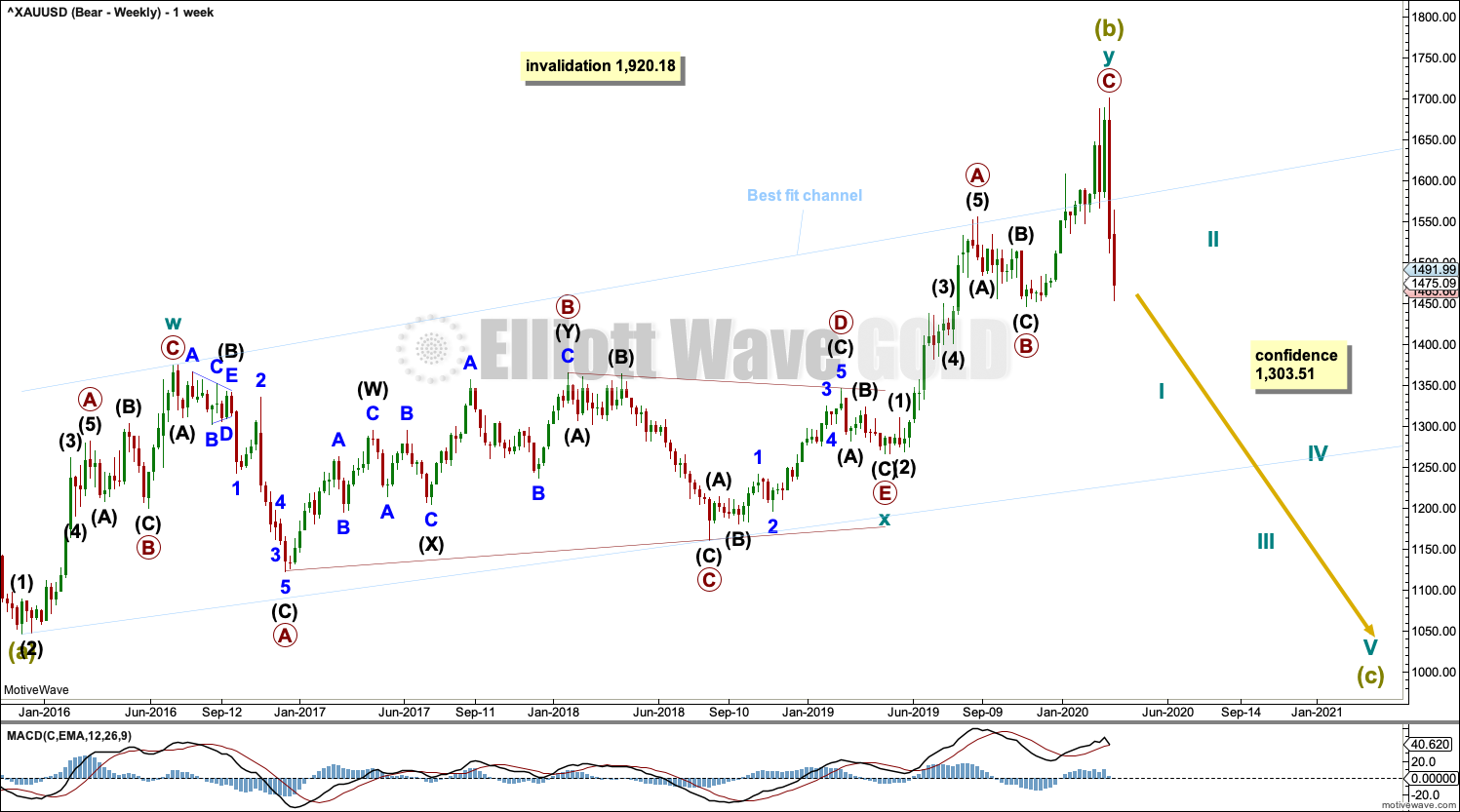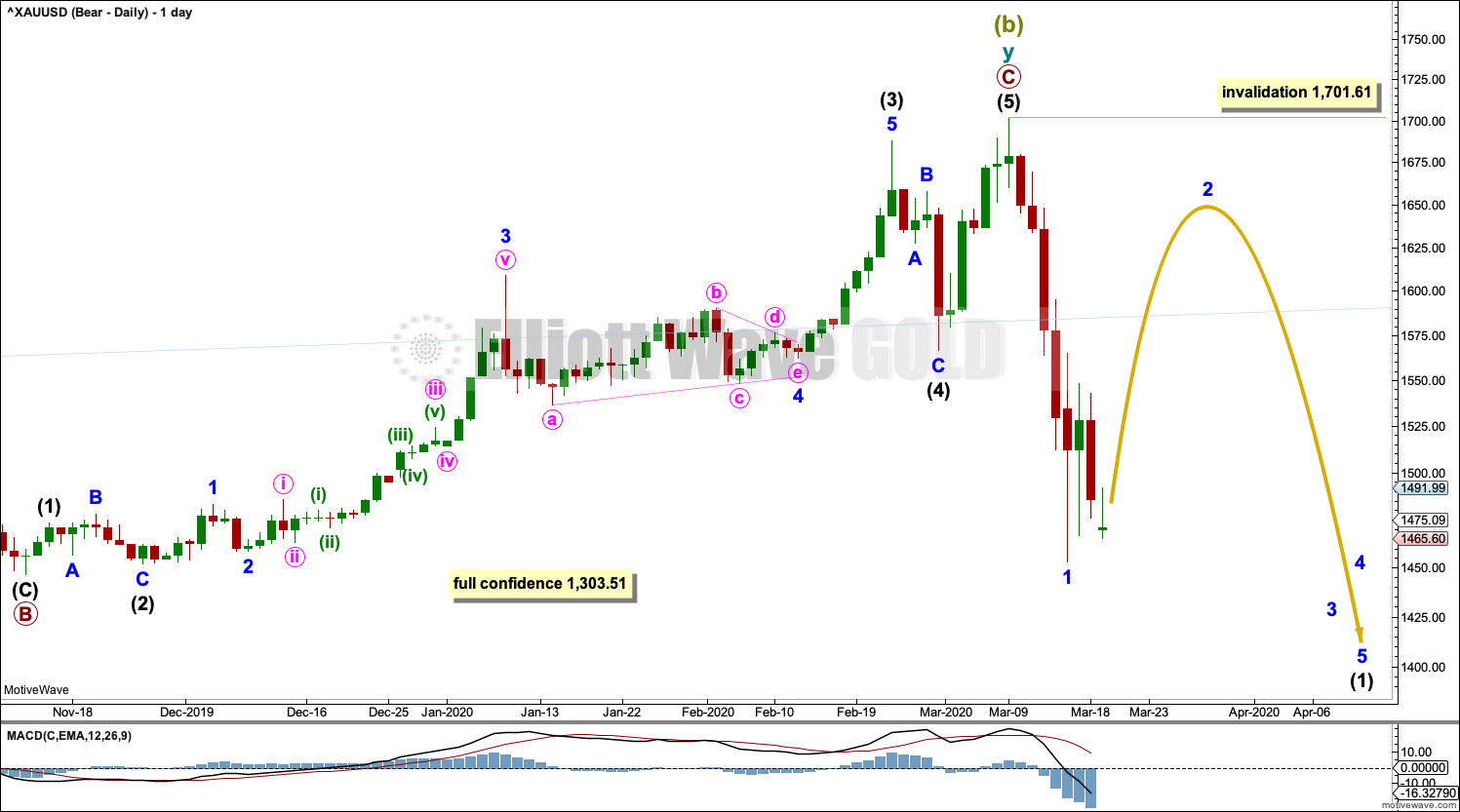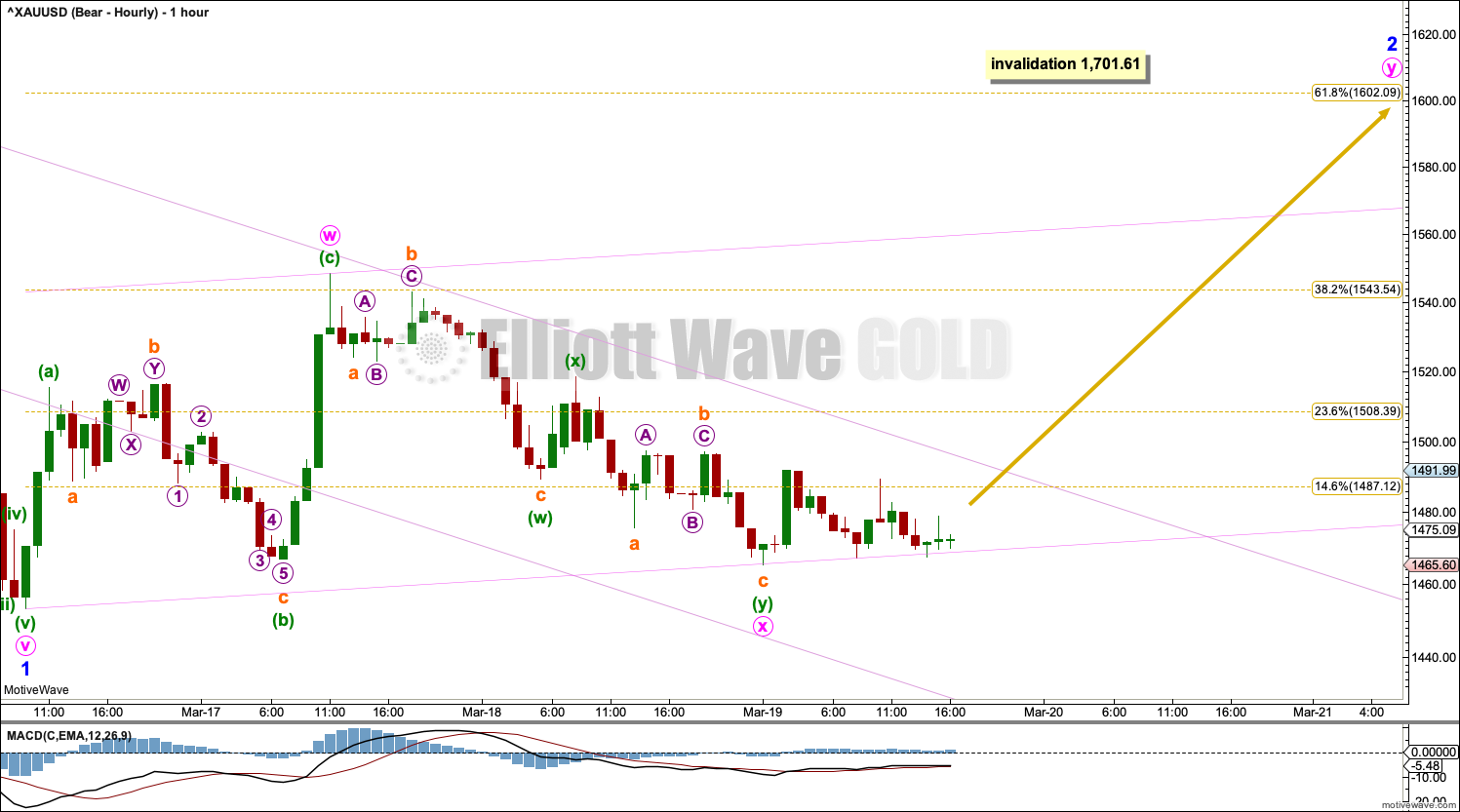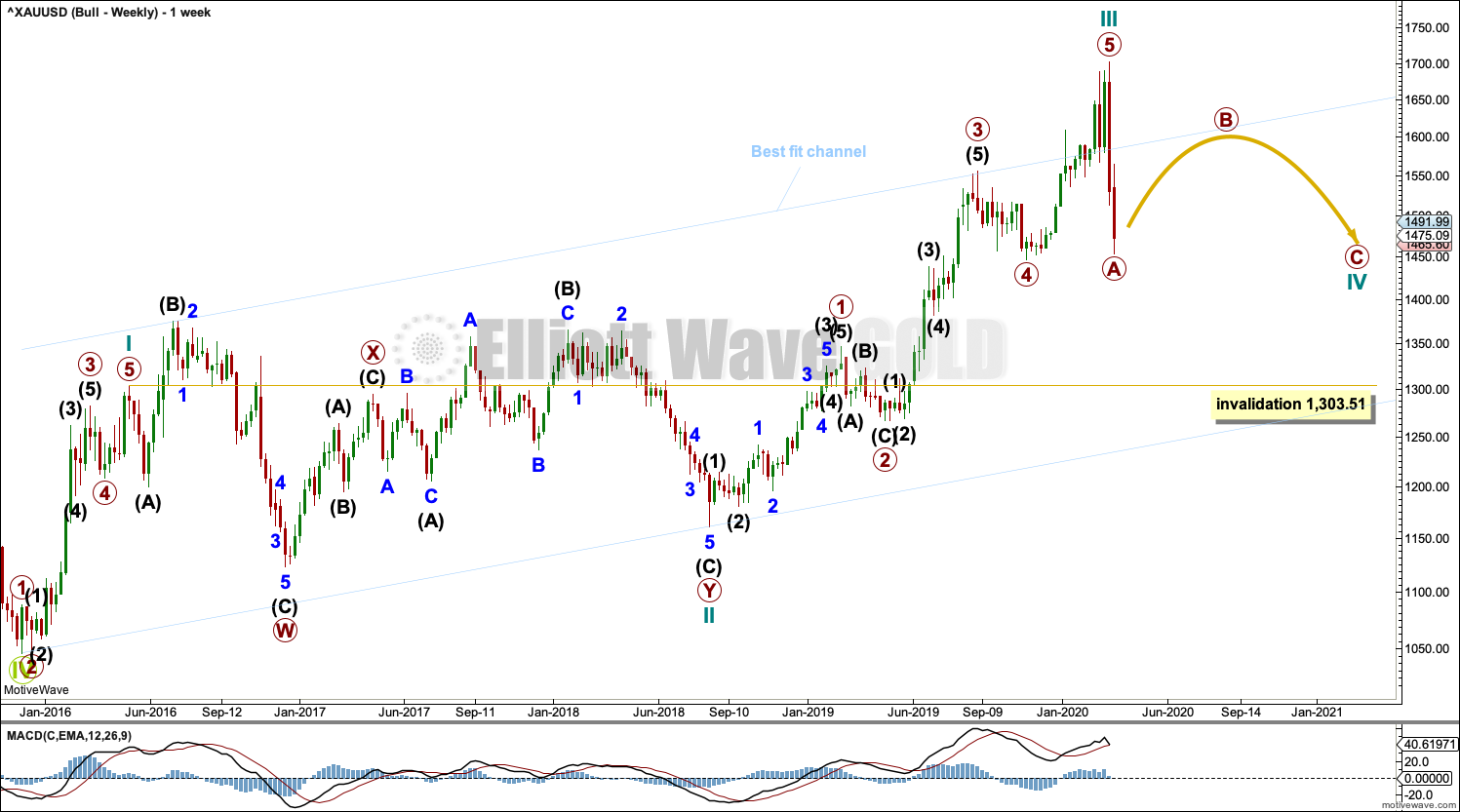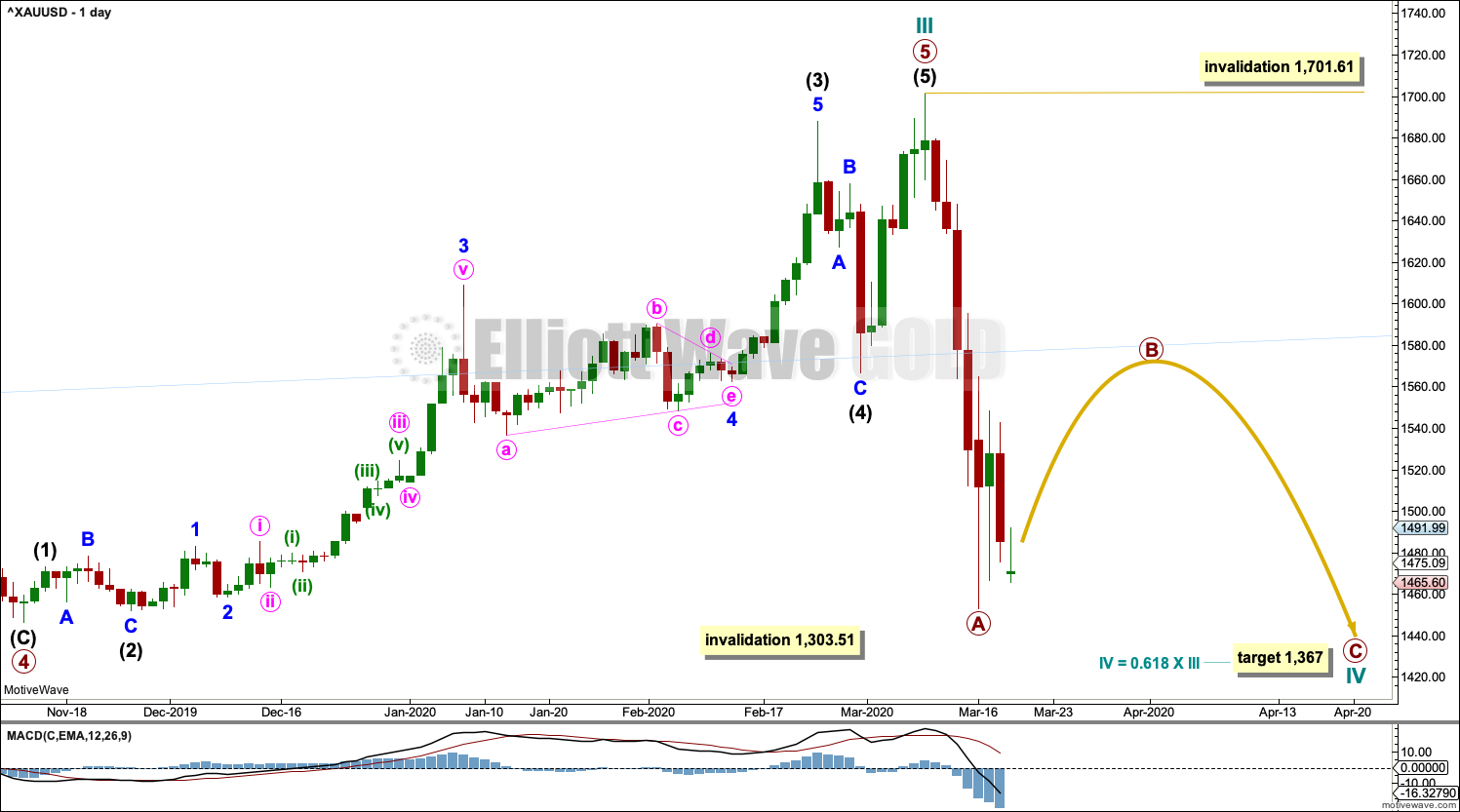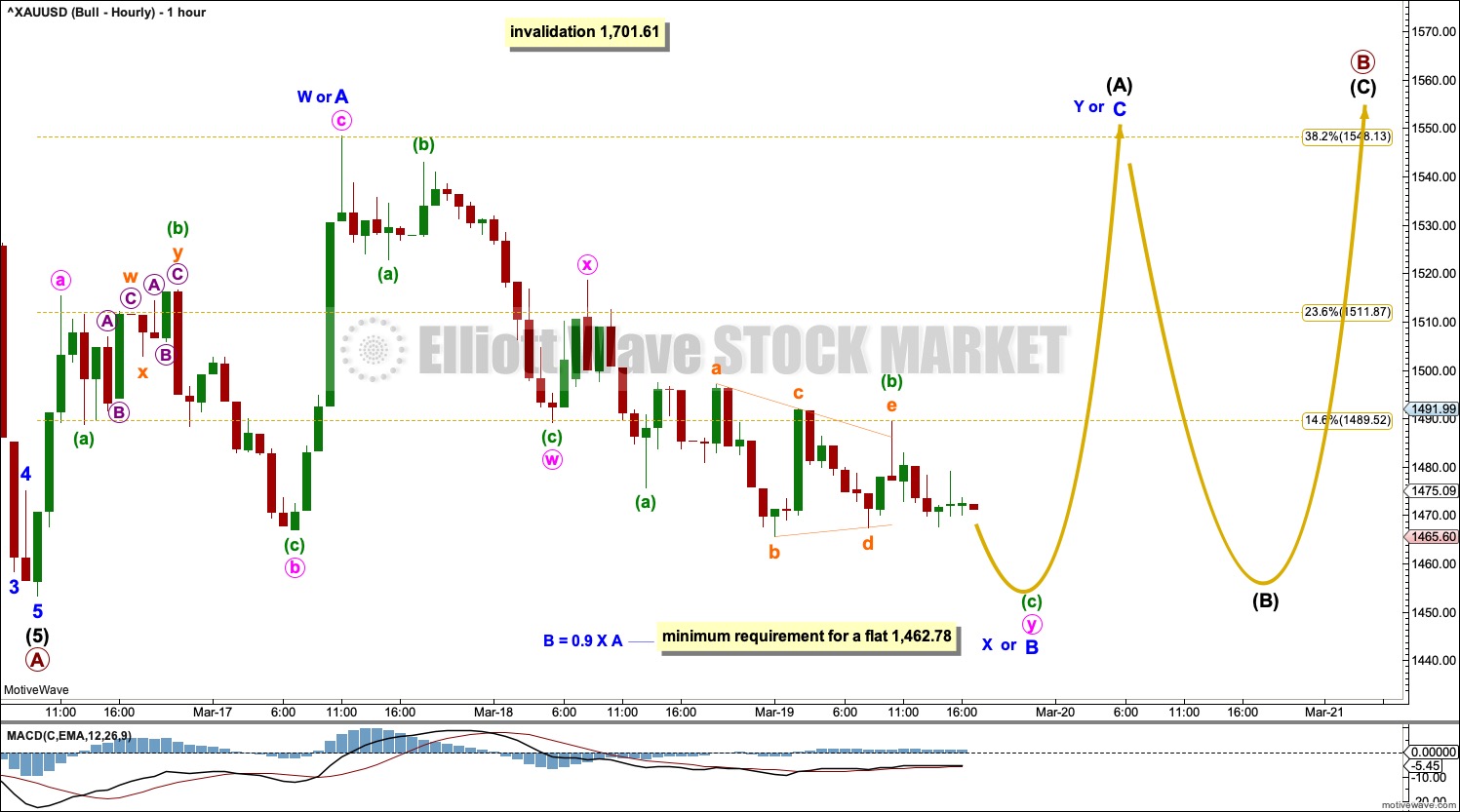GOLD: Elliott Wave and Technical Analysis | Charts – March 19, 2020
Another small range day sees price move mostly sideways. The analysis has been expecting a bounce or consolidation to unfold, so this is mostly what was expected.
Summary: A bounce may have begun. It may be fairly deep. It may be either quick and sharp, or it may be a time consuming sideways consolidation. The 0.618 Fibonacci ratio at 1,602 may be a preferred target.
Grand SuperCycle analysis is here.
Monthly charts were last updated here.
BEARISH ELLIOTT WAVE COUNT
WEEKLY CHART
Super Cycle wave (b) may be a complete double zigzag.
The first zigzag in the double is labelled cycle wave w. The double is joined by a three in the opposite direction, a triangle labelled cycle wave x. The second zigzag in the double is labelled cycle wave y.
The purpose of the second zigzag in a double is to deepen the correction. Cycle wave y has achieved this purpose.
A wide best fit channel is added in light blue. Copy this channel over to daily charts. Price has now closed back below the upper edge of this channel.
DAILY CHART
Super Cycle wave (b) may be complete.
The second zigzag in the double, labelled cycle wave y, may be complete. There is no Fibonacci ratio between primary waves A and C.
If there was a trend change at Super Cycle degree, then a five down should develop at daily, weekly and monthly time frames. The first five down at the daily chart level will be labelled intermediate wave (1), and it may be incomplete. Within intermediate wave (1), minor wave 1 may now be complete and minor wave 2 may not move beyond the start of minor wave 1 above 1,701.61.
HOURLY CHART
The first five down on the hourly chart is labelled minor wave 1, and it may be now complete.
Minor wave 2 may be reasonably expected to most likely be very deep. The 0.618 Fibonacci ratio may be favoured; this target may not be high enough. Gold typically exhibits very deep corrections at the beginning of its new trends.
Minor wave 2 may subdivide as any Elliott wave corrective structure except a triangle. It would most likely subdivide as a single or multiple zigzag by a fairly wide margin.
Minor wave 2 may be subdividing as a double zigzag. The first zigzag in the double may be complete and is labelled minute wave w. The double may now be joined by a three in the opposite direction, which may be an incomplete double zigzag labelled minute wave x. A target is given for minute wave x to complete.
Labelling for primary wave B on the alternate hourly chart also would work for minor wave 2. Minor wave 2 may subdivide as a flat or combination.
Minor wave 2 may not move beyond the start of minor wave 1 above 1,701.61.
BULLISH ELLIOTT WAVE COUNT
WEEKLY CHART
This wave count sees the the bear market complete at the last major low for Gold on 3 December 2015.
If Gold is in a new bull market, then it should begin with a five wave structure upwards on the weekly chart.
Cycle wave I fits as a five wave impulse with reasonably proportionate corrections for primary waves 2 and 4. This resolves a previous major problem with the bullish wave count.
Cycle wave II now fits as a double flat. However, a problem arises with the relabelling of this structure. Within the first flat correction labelled primary wave W, this wave count now needs to ignore what looks like an obvious triangle from July to September 2016 (this can be seen labelled as a triangle on the bear wave count above). This movement must now be labelled as a series of overlapping first and second waves.
Within the first flat correction labelled primary wave W of the double flat of cycle wave II, intermediate wave (B) is 1.69 the length of intermediate wave (A). This is longer than the common range of up to 1.38, but within an allowable guideline of up to 2. The length of intermediate wave (B) reduces the probability of this wave count.
Cycle wave III may be complete. Cycle wave IV may not move into cycle wave I price territory below 1,303.51.
DAILY CHART
Cycle wave III may be complete. Cycle wave IV may not move into cycle wave I price territory below 1,303.51.
Cycle wave II was relatively deep at 0.55 of cycle wave I. If cycle wave IV exhibits alternation in depth, it may more likely be shallow; the first target at 0.382 of cycle wave III would be preferred.
Cycle wave II was a very long lasting double combination. It lasted 119 weeks. Cycle wave IV may most likely be a zigzag, which tend to be quicker structures, but it would still be expected to last several months.
HOURLY CHART
A three up may be expected to follow a five down. This bullish wave count will label it primary wave B.
Primary wave B may subdivide as any corrective Elliott wave structure, including a triangle. Primary wave B may not move beyond the start of primary wave A above 1,701.61.
Primary wave B may also subdivide as a double zigzag in the same way that minor wave 2 is labelled on the bearish hourly chart. Both hourly charts work in the same way for both bull and bear wave counts at this time.
This hourly chart considers the possibility that primary wave B may subdivide as a flat, combination or triangle. All of these Elliott wave structures begin with intermediate wave (A) subdividing as a three wave structure.
Intermediate wave (A) may be subdividing as a flat correction or a double zigzag.
If intermediate wave (A) is subdividing as a flat correction, then within it minor wave B must now retrace a minimum 90% of minor wave A at 1,462.78. Minor wave B may make a new low below the start of minor wave A at 1,453.26 as in an expanded flat.
Intermediate wave (A) may be subdividing as a double zigzag. Minor wave W, the first zigzag in a double, may be complete. The double would now be expected to be joined by a three in the opposite direction, which would be labelled minor wave X. There is no minimum requirement for minor wave X and minor wave X may make a new low below the start of minor wave W at 1,453.26.
There is no lower invalidation point for this wave count.
TECHNICAL ANALYSIS
WEEKLY CHART
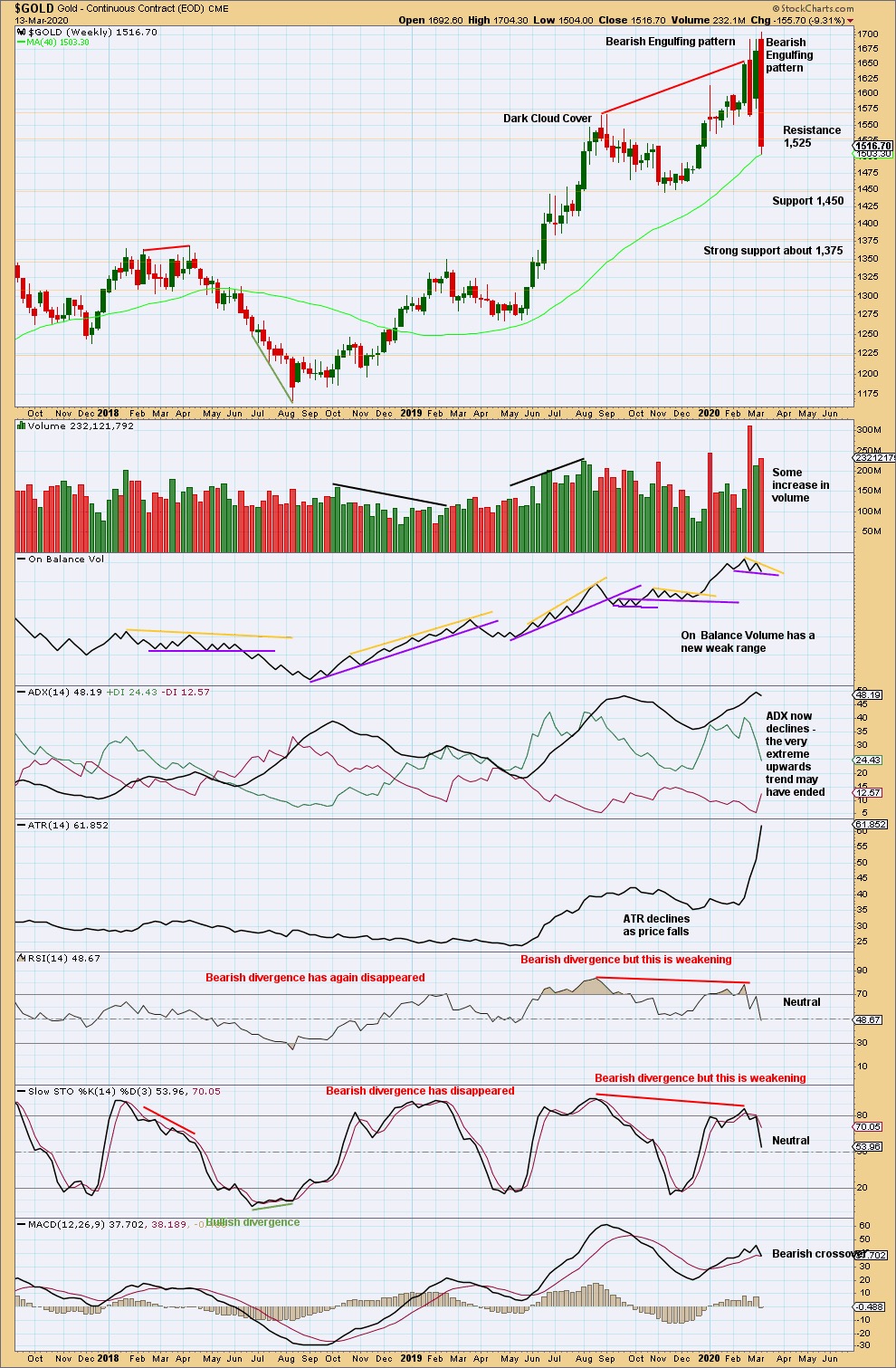
Click chart to enlarge. Chart courtesy of StockCharts.com.
Last week’s Bearish Engulfing pattern is extreme. The pattern fully engulfs the prior nine weekly candlesticks, and it has some support from volume. This strongly indicates a trend change after the upwards trend reached very extreme and conditions reached overbought and exhibited bearish divergence.
Price does not move in straight lines. Look out for bounces and consolidations on the way down. Look for support below about 1,450 to 1,455, and below that very strong support about 1,375.
DAILY CHART
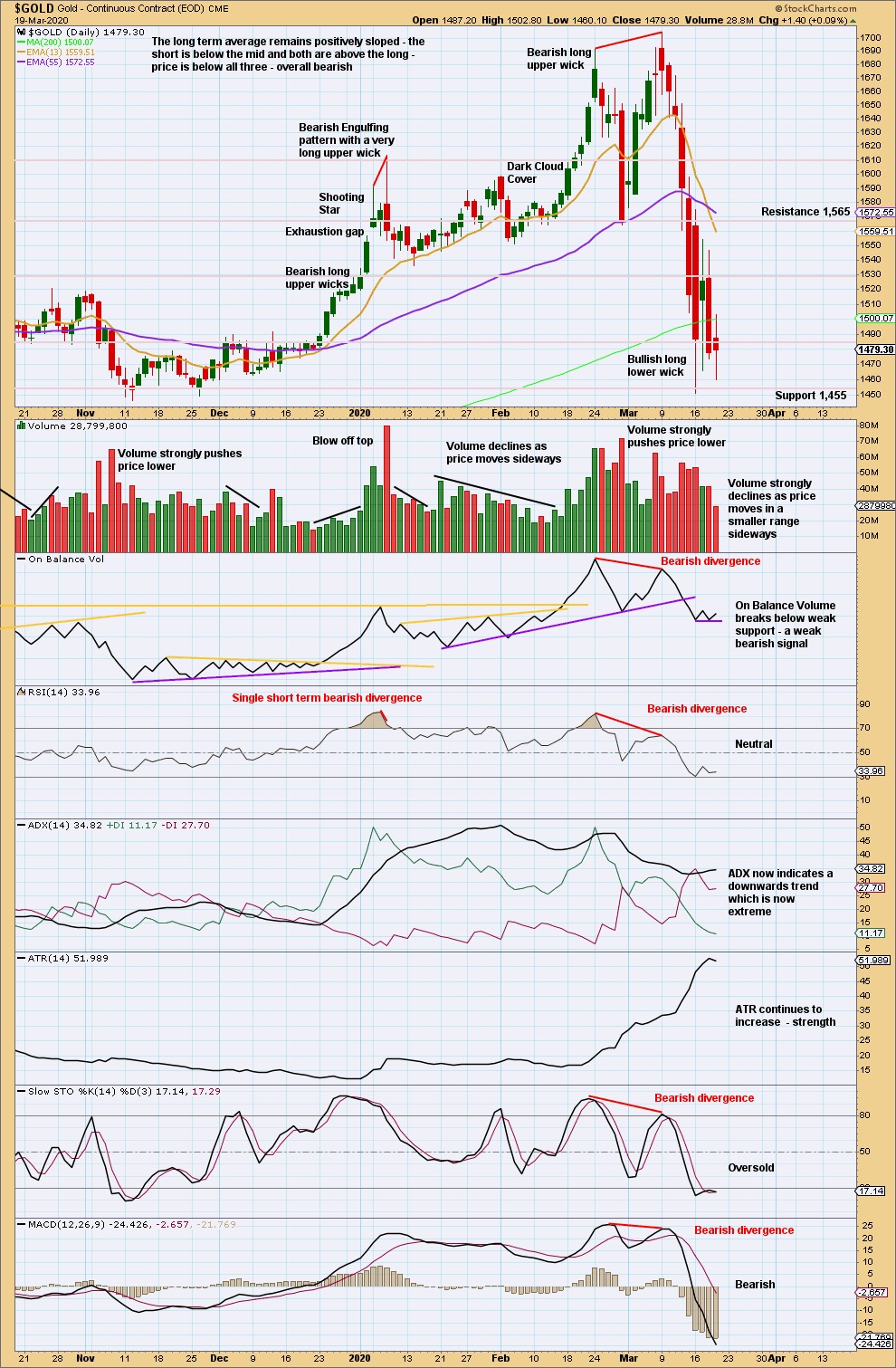
Click chart to enlarge. Chart courtesy of StockCharts.com.
There is now bearish divergence between price and all of On Balance Volume, RSI, Stochastics and MACD. The risk of a trend change to either sideways or a 180° change is high. A new swing low below 1,564 (February 28, 2020) provides some indiction of a possible trend change.
Overall, price has moved mostly sideways for the last three sessions with a decline in range and today a sharp decline in volume. This looks like a small pause within an ongoing new downwards trend.
GDX WEEKLY CHART
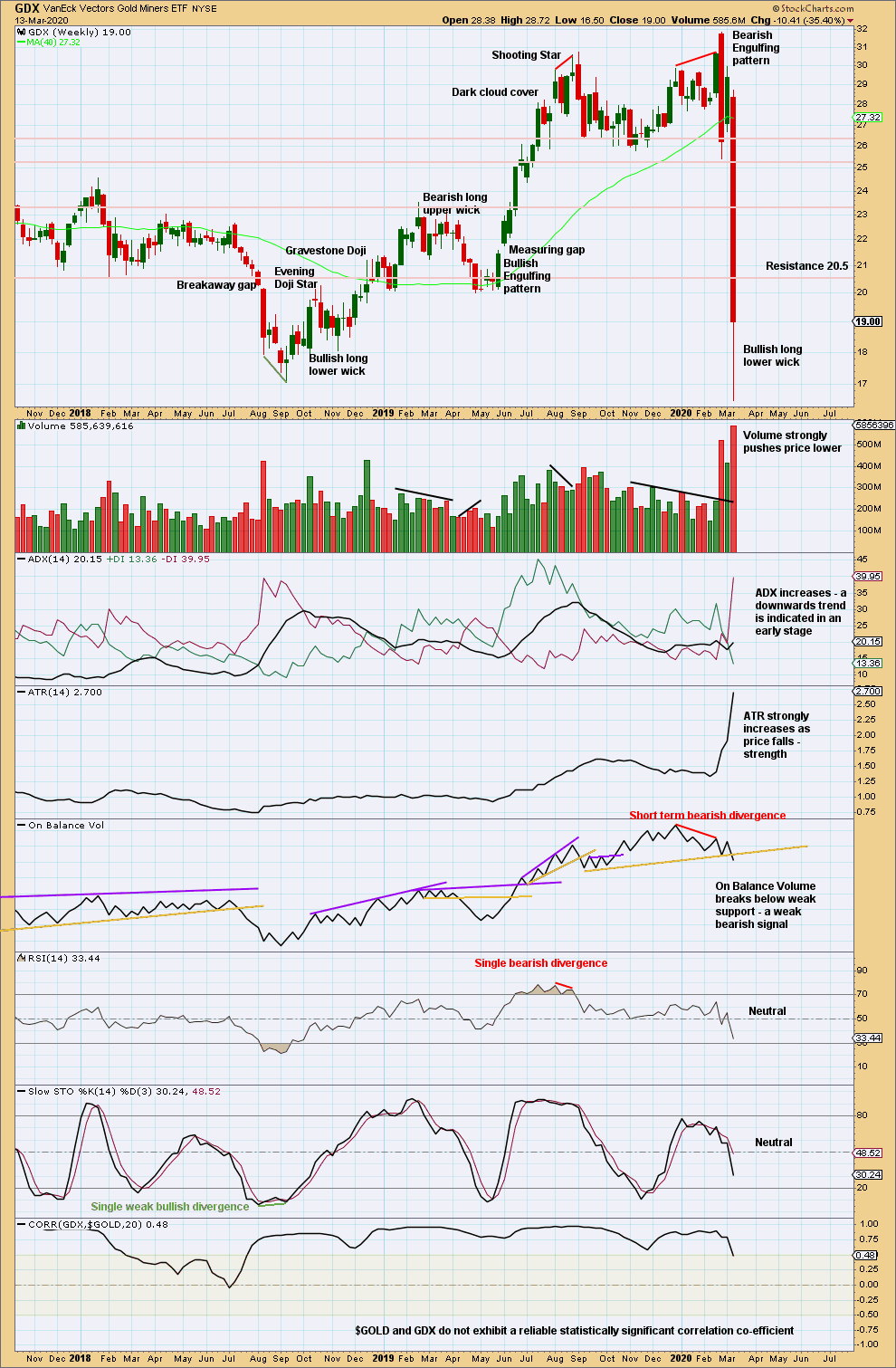
Click chart to enlarge. Chart courtesy of StockCharts.com.
GDX is a reasonable distance off new highs. The last signal was very bearish from a strong Bearish Engulfing pattern.
There is support below in a zone about 16.75 to 15.85. Price has bounced up strongly again within this zone.
GDX DAILY CHART
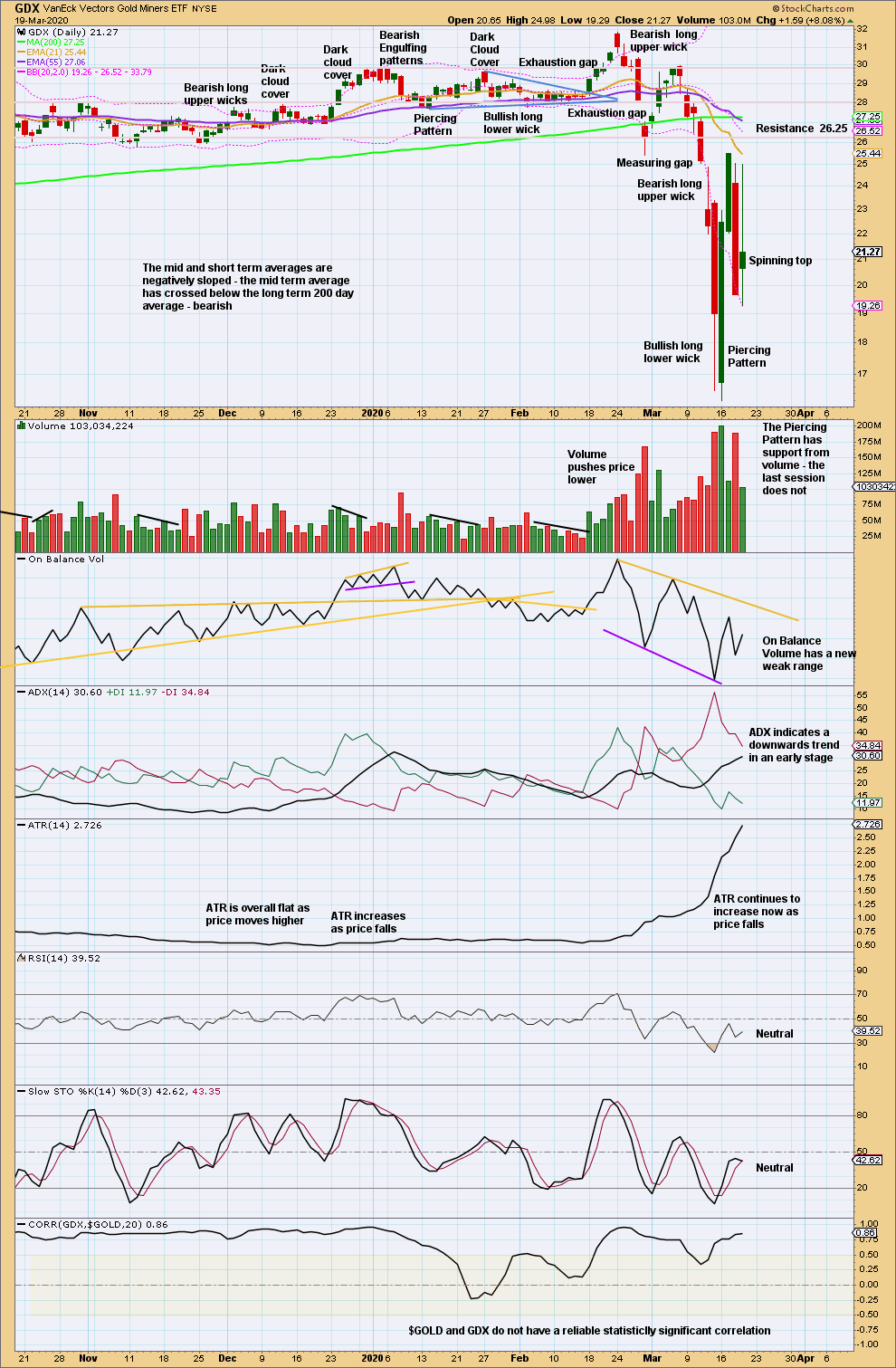
Click chart to enlarge. Chart courtesy of StockCharts.com.
There has been a trend change to downwards. This trend has support from volume pushing price lower and exhibits strength in increasing ATR.
Today the 55 day moving average has crossed below the 200 day moving average. This is fairly bearish.
Published @ 07:43 p.m. EST.
—
Careful risk management protects your trading account(s).
Follow my two Golden Rules:
1. Always trade with stops.
2. Risk only 1-5% of equity on any one trade.
—
New updates to this analysis are in bold.

